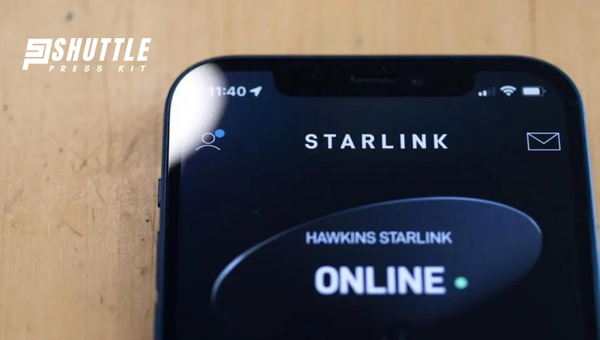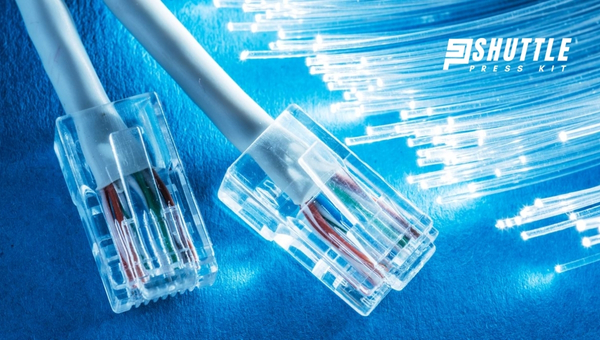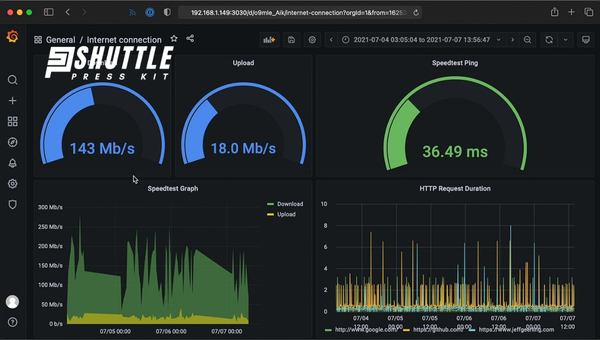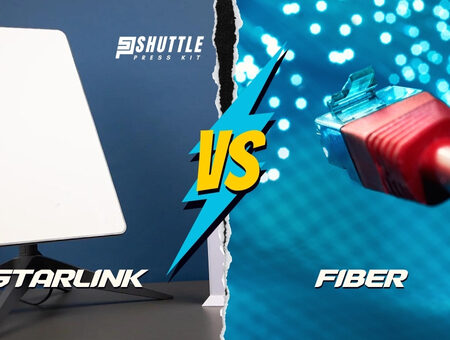Let’s talk about a match made for the modern age: Starlink vs Fiber. Picture two speedsters racing in the world of the internet. That’s what we’ve got with these two options.
Now, you might be scratching your head, thinking, “Why should I care?” Well, picture this: endless movies without that annoying spinning wheel of loading doom. Tempting, right? That’s why this battle for high-speed internet is big news.
When it comes down to picking between Starlink and fiber internet, think about horses versus rockets. Both will get you where you need to go but at different speeds and experiences. Fiber has been king for a while – it’s like a smooth freeway with consistent speeds.
Meanwhile, Starlink is more like a space shuttle – new tech reaching even remote areas fast! The key here is your need for speed or coverage; if consistency is your jam, fiber’s got your back. But if you’re off the beaten path and longing for lightning-fast downloads from above, then Starlink’s satellites might just be your new best friends.
| Feature | Starlink | Fiber |
|---|---|---|
| Technology | Satellite | Wired connection |
| Speed | Up to 150-500 Mbps | Up to 1 Gbps or more |
| Latency | 20-40 ms | 1-10 ms |
| Availability | Global, focusing on rural or remote areas first | Primarily urban and suburban areas |
| Installation | Requires a clear view of the sky, easy setup | Requires professional installation, infrastructure dependent |
| Cost | Potentially high initial setup cost, monthly fees vary | Installation and monthly fees vary, and typically require contract |
| Weather Dependence | Yes, performance can decrease during bad weather | No, generally not affected by weather |
| Mobility | Currently, no strict data caps announced | No, fixed location |
| Data Caps | Installation and monthly fees vary, and typically require a contract | Often unlimited, but policies vary by provider |
What is Starlink?
Starlink, in simple terms, is a satellite internet service provided by SpaceX, a company founded by billionaire entrepreneur Elon Musk.

It aims to deliver high-speed internet access to people around the globe, particularly those in remote areas with limited options for connectivity.
The Technology Behind Starlink
Underneath the hood of Starlink lies some very exciting and innovative technology. At its core are low-Earth orbit satellites, or simply LEOs. What makes LEOs special? Well, unlike traditional satellite networks that operate at a higher altitude (usually faraway geostationary orbits), these circulate at much closer proximity to the Earth – typically below 2,000 kilometers (around 1,200 miles).
Why does this matter? The answer can be boiled down to one word: latency. Latency refers to the time it takes for data to travel from one place to another – it’s like a courier making his delivery rounds, but every millisecond counts here! Having closer proximity reduces this time delay and ensures faster data return response, leading eventually to better Internet performance.
Advancements and Deployment
The idea of using thousands of small satellites revolving close around our planet together might sound like stuff from science fiction before – until SpaceX made them into reality! These miniaturized machines are being launched into space literally by hundreds on each Falcon 9 rocket flight as part of ambitious Starlink project deployment.
As things currently stand, over 1,700 operational satellites have been sent up above already, which is no small feat considering we’re still in early development stages here! There’s also news about obtaining permission to launch tens of thousands more units ahead in future years, which indicates just how seriously Musk company envisages bridging the digital divide worldwide through their tech innovation.
Also Read: Starlink Port Forwarding Guide: Steps for Secure Connections
Fiber-Optic Internet Explained
Understanding the function and benefits of fiber-optic internet can seem daunting, especially if you’re not a tech guru.

But don’t worry! We’ll break it all down into simple, easy-to-understand language for you.
How Does Fiber Internet Work?
In essence, fiber-optic technology transmits information as light pulses through thin strands of glass or plastic, known as optical fibers. Unlike traditional copper cables that transfer electrical signals, these fibers are immune to electromagnetic interference which allows data to travel longer distances without loss in quality.
Now think about this—the data in your Netflix stream or Zoom call is translated into pulses of light that zip through these lines, connecting your home network to wider global networks!
Benefits of Fiber Connectivity
But why should we care about the technology underpinning our internet connection? Well, when it comes to reaping real-world benefits – it’s no small matter.
- Bandwidth: Your fiber optic connection isn’t affected by how many people are using the network or peak times throughout the day—it consistently delivers high-speed connectivity.
- Speed: With fiber internet, download and upload speeds can reach up to 1 Gigabit per second—that’s unfathomably quick!
- Latency: This is essentially how much time it takes for a piece of information (a ‘packet’ in tech jargon) from one point to another. Lower latency means less delay—something crucial for gamers and video calling.
- Reliability: Weather and temperature changes won’t slow down your services because optical fibers are more resilient to environmental disturbances than other cable types.
The next time you sit down for an intense gaming session or stream a 4k movie with zero buffering issues—remember—you have this technological marvel running underneath you: blazing-fast and resilient fiber-optic connections!
Also Read: How to Activate Starlink from Dish? Effortless Connection
Fiber Speed Comparison
Let’s take a dive into the exciting world of internet speeds. Here, we’ll put Starlink and fiber optic services to the test with a comprehensive speed comparison.
Analyzing Speeds: The Theoretical Maximums
At first glance, theoretical maximum speed seems like an impressive measure of an internet service. For our contenders, Starlink boasts a looming potential with estimated speeds up to 100 Megabits per second (Mbps).
On the other hand, fiber optic services can effortlessly flaunt Gigabits per second (Gbps), translating to thousands of Mbps. It appears clear that fiber optics takes the lead when we whisper about theoretical speeds.
Real-World Performance
However, there’s more to this story than cold hard numbers. By venturing beyond laboratory limits and stepping into real-world conditions, we encounter different results altogether. Based on user experiences, Starlink provides an average download speed hovering around 150 Mbps—surpassing their projected figures!
Fiber optics also offer outstanding results but can sometimes drop below Gbps levels due to factors like network congestion or infrastructure issues. So in terms of real-world reliability and consistency, it seems that both Starlink and fiber have their unique strengths.
Factors That Affect Internet Speed
When it comes to internet speed, several factors come into play, some linked to the type of technology in use.

For instance, satellite-based services like Starlink and traditional fiber-optic installations don’t operate under the same conditions. As a result, each model has unique susceptibilities affecting its overall performance.
Satellite Internet Variables (Starlink Considerations)
The efficiency of Starlink’s service primarily relies on signal transmission between satellites hovering in low-Earth orbit and user terminals on the ground. Now let’s take a quick look at how different aspects influence this process:
| Factors | Impact |
|---|---|
| Weather Conditions | Poor weather can degrade signal quality since electromagnetic waves pass through the atmosphere both ways during transmission. |
| Physical Obstacles | Buildings or natural features may interrupt signals if they’re substantial enough or positioned between a user’s terminal and straight-line path to a satellite. |
Fiber Infrastructure Dependability
On the other hand, fiber-optic networks have shown impressive reliability due to their solid foundation on established infrastructure. This network primarily comprises underground cables free from common atmospheric interferences that affect satellite transmissions.
Yet fiber isn’t without its vulnerabilities:
- Infrastructure damage from construction work could disrupt service.
- Routing issues among network nodes might slow your connection speeds.
- Overloaded networks during peak usage times can still bring about internet slowdowns.
So while fiber might generally offer more constant speeds over time thanks to its robust infrastructure, no system is immune from potential disturbances that could impact performance.
Also Read: Starlink Warranty And Claim Guide: Easy Steps Revealed
Accessibility and Coverage: A Crucial Battlefront
In our advancing digital world, accessibility and coverage are becoming major deciding factors in choosing an internet service. That’s where Starlink and fiber optic services often find themselves in a tug of war.
Rural Accessibility Challenge
Many remote areas have been left in the dust by conventional cable or fiber services. Rural spots often grapple with poor connectivity, making it difficult for residents to access a reliable internet connection. This gap is where Starlink seizes the opportunity to shine.
Provided by SpaceX, Starlink employs low-Earth orbit satellites to deliver broadband services to even the most remote corners of our planet where laying physical cables is not possible or cost-effective. This advantage puts Starlink squarely on top when it comes to accessibility in rural settings, offering hope for folks who’ve typically been under-served by traditional providers.
Urban Coverage Superiority
Don’t count out fiber just yet though! If you’re residing in bustling cities with dense populations, chances are your best bet lies within existing fiber networks. Why?
Well, urban environments usually boast well-built infrastructure which favors cable-based solutions like fiber optics due to its capacity for high speeds and greater reliability. Plus, tall buildings packed close together aren’t ideal for satellite signals which prefer a clear path between the satellite dish and the sky.
While future advancements might tip these scales differently someday (we’re looking at you Musk!), as things stand right now – rural areas could benefit from Starlink’s broad coverage while urban dwellers may find stronger performance from their local fiber networks.
Cost Analysis: Investment vs Return on Experience
When it comes to choosing an internet service, it’s not just about speed. You have to consider how much bang you’re getting for your buck.

This means looking at the cost of subscription versus the quality of service you receive, a.k.a., your return on experience.
Price per Mbps – Is Starlink Worth It?
Starlink deals in snippets of quick data delivery over great distances. Its price might seem higher at a glance when compared to typical fiber optic packages. After all, its subscription currently stands around $99/month with a rather steep upfront cost for equipment — close to $500!
Now compare this with fiber optics packages which can range from as low as $40/month up to around $80/month without extra equipment fees.
But let’s not rush into judgments! When we delve deeper into what each service offers, we discover more about value beyond just dollars spent – like geographical advantage or scarcity of alternative high-speed internet services in an area. Factors like these can push the scale toward Starlink despite the obvious cost differences.
Remember, our aim is maximum satisfaction delivered per dollar spent! Simply measuring totality and ignoring peculiar benefits is like valuing an apple and orange based solely on their weights while disregarding taste preference!
Also Read: Starlink Roam vs Starlink Residential: What’s Best for You?
Frequently Asked Questions
Can I get Starlink anywhere in the world?
Not yet, but Starlink is rapidly expanding coverage and plans to offer worldwide service.
Does weather affect Starlink’s internet speed?
Yes, severe weather could potentially disrupt the satellite signal causing slower speeds or service drops.
Is fiber-optic internet more reliable than Starlink?
Typically, yes. Fiber-optic connections aren’t affected by conditions that impact satellite-based services like weather or physical obstructions.
Does fiber offer better latency than Starlink for gaming purposes?
In general, fiber often has lower latency compared to any satellite-based service, making it a preferred choice for gamers.
Are there extra costs involved with the initial setup of Starlink service?
Yes, apart from the monthly subscription fee, there’s an upfront cost close to $500 for equipment including a receiver dish and modem.
Also Read: Starlink Maritime: Revolutionizing Connectivity at Sea
Conclusion
Pinning down the victor in the tussle between Starlink and Fiber depends largely on personal circumstances. If you’re seeking undisturbed monster speeds with lower latency, fiber likely appeals more. But don’t be quick to disparage Starlink just yet! For the digitally under-served stretching out in rural or remote corners of the world, it’s a broadband blessing.
Yes, it’s pricey and might not promise that zippy ‘under-a-millisecond’ latency (at least for now), but remember, satellite technology is on an uptick. Future improvements could be game-changers for the speed, reliability, and cost-effectiveness of satellite internet. Until then, our verdict sways with where you live and what you need from your net.
